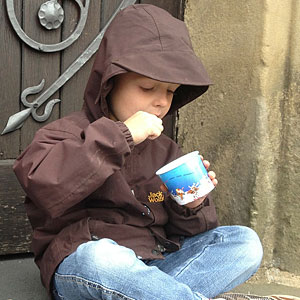At some point, every person with ARFID asks themselves these simple questions:
I’d like to eat something different, but when I try I just can’t.
Why does this happen to me? Why can’t I be like everyone else?
What is it that overrides the logical wants of an ARFID person, and prevents them from expanding their safe group of foods? This article will get to the heart of this dilemma. But firstly, what is ARFID?
What is ARFID?
ARFID is the acronym for Avoidant Restrictive Food Intake Disorder. Since 2013 ARFID has been listed as a recognised Eating Disorder in the DSM-5 (the Diagnostic and Statistical Manual of Mental Disorders).
ARFID is not Fussy Eating. A Fussy Eater might refuse to eat a food, but if they WANTED to eat the food, they could. An element of Fussy Eating is normal for many children as taste buds develop and sensory experiences begin to be normalised. And importantly, a Fussy Eater typically will grow out of this phase.

However, the ARFID person’s behaviour and reaction to food is quite different. The ARFID person may be hungry, may want to eat the food, but their brain stops them from eating the food or swallowing it. The outward appearance is of a person that is scared to eat the food, or avoids and shows disinterest in trying new food.
For ARFID children, adolescents and adults this behaviour may display as a tantrum or fearfulavoidance, there may be a feeling of heightened anxiety and gagging, and for others it may show as total disinterest, as if they have given up on trying new food.
At its core, ARFID is a food phobia. Someone with ARFID cannot be bribed to eat new food. They would rather starve, and unfortunately malnutrition and severe dietary health problems can be a consequence of ARFID behaviours.
The CONSCIOUS MIND making decisions
So let’s look at examples of people trying new things (not food).
Imagine you decide to go to a cinema to see a new film. As you wait to go into the cinema, you don’t know what to expect; will it be good, will it be bad? You don’t know until you sit through the film and watch. Even if you have seen a bad film in the past, it typically does not stop you from going again to the cinema. You are curious and decide to watch the film.
Now let’s look at riding a bicycle. Imagine as a young child you have successfully removed thetrainer wheels and are happily riding your bike. Then one day you have a crash and injure yourself (a scraped knee or elbow). What happens the next time you go to ride the bike? Memories might come back of the crash, you might feel a little nervous, you might be more careful, but as you take it slowly your confidence builds and you are back riding the bike.
In both of the above examples it is our CONSCIOUS MIND that works through the challenge. We use logic to assess the situation and make decisions. (In the case of the movie, we reason that not all movies can be bad, so it’s worthwhile watching another; and in the case of the bike, we know we were riding OK before the crash, so we take our time and slowly build back our confidence to riding at normal speed).
The SUBCONSCIOUS MIND making decisions
But what happens if the challenge we are facing occurs before our CONSCIOUS MIND is active? We see this often with animal phobias. Imagine a two year old child that is bitten by the family dog. The bite causes both physical and emotional damage. There are feelings of fear, hurt, pain, and probably betrayal or mistrust (being bitten by a pet that was previously a friend). As the years roll on, the child (now adolescent or adult) may have no CONSCIOUS memory of the event. Yet inside them, at a deeper more primitive and emotional level, there is a SUBCONSCIOUS memory of an animal caused injury that is overlaid withfear and high emotion.
This may cause the person to have a SUBCONSCIOUS fear and anxiety around dogs, without the person CONSCIOUSLY understanding why.
As humans, we rely on these instinctive SUBCONSCIOUS reactions to keep us safe, and to build a memory of potential threats to avoid. And these reactions are perfectly OK in the moment. They are perfectly OK for the age and in the context that we experience the discomfort. But sometimes, instead of letting go of (or upgrading) these old reactions and behaviours, they get ‘locked in time’ and run like a program in our mind on a never-ending loop.
ARFID is like wearing old small shoes
Instinctively, we know when to let things go. Like shoes. As we grow up and our feet become bigger, we know when it’s time to let go of old shoes. They are tight, uncomfortable, and no longer serve their purpose. We do this naturally. We don’t force ourselves to wear shoes that no longer fit.
And beliefs are like that too. Many young children believe in the Easter Bunny. And then there comes a time as they grow older, when they no longer believe. The old way of thinking is no longer useful for them.
ARFID is an old behaviour pattern that has been running on a loop, often from when the child was very small. It is a behaviour that should have been discarded years ago, like old shoes, but somehow it has continued to run. So how do we upgrade and change this old behaviour?
Upgrading ARFID behaviour
Firstly, we have to understand why the program started in the first place. For most ARFID sufferers, it was a protection program. Something happened, the body felt uncomfortable or sick, and food got the blame. The inner mind instinctively restricted the type of food allowed in the body as a form of protection.

But how could food harm the body? In reality, this can happen very easily to a young baby or toddler. Things like colic, reflux, gastro, food allergies, food trauma from choking, an uncomfortable feeling moving from liquid to solids, sickness from immunizations, tongue tie, emotional upheaval, etc., can create acute pain in the young body.
The protective (SUBCONSCIOUS) inner part of the mind has the job to ensure our survival and move us away from pain. A decision is made by this SUBCONSCIOUS inner part of the mind (rightly or wrongly) that food has somehow caused distress to the body. It responds by being wary of food, restricting food, and reverting to a small selection of safe foods. If the pain subsides, it determines the strategy a success, and repeats in a perpetual protective loop.
And here is an interesting truth. The way this part protects us when we are young is perfectly OK. It did its job well. But here is the key to the ARFID problem. The physical body grows up and matures, but the protective inner part continues to protect the body like it is still a toddler. So we have an adolescent or adult that only eats a small selection of beige foods… just like a toddler. It’s like the toddler part of us in charge of the menu.
Moving beyond ARFID
Smokers understand this concept only too well. Smokers say to me, “I want to give up smoking. It’s bad for my health, my lungs, my heart and my wallet. But there is this strong inner part of me that wants to keep smoking. And this part is stronger than my willpower!”
And when I give this example to my ARFID clients, they all say, “That’s exactly how I feel about food!”. When our logical mind wants one thing, but our body and behaviour prevents it from happening, it generally signifies a conflict between the CONSCIOUS and SUBCONSCIOUS MIND.
ARFID Therapy provides the client with the opportunity to become aware of this inner part of their mind that is perpetuating the ARFID behaviour. The ARFID Therapy enables the client to understand and ‘talk’ to this part of them. This process demystifies the negative beliefs and behaviours they have been experiencing. With new understanding comes a reduction in fear. With a reduction in fear comes the ability to calmly try new food.
ARFID is an Eating Disorder that can be overcome with proper professional help. It is never too late to change.
Article by:
Glenn Robertson
Psychotherapist, ARFID Specialist




